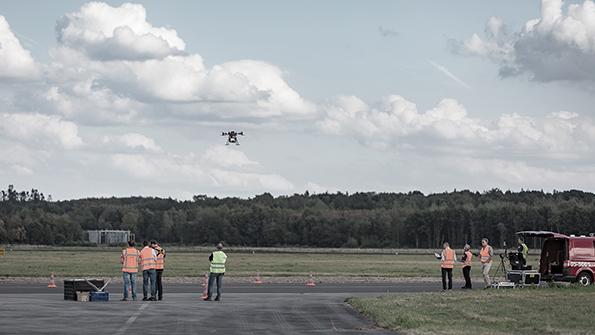
Plans to develop an MRO cluster at Twente Airport in the Netherlands will be pared back in favor of exploring services for testing new technologies and opening for business aviation flights, as the site’s organizers plot a long-term pathway.
Despite challenges for the commercial aftermarket related to the COVID-19 pandemic, plans to build Aircraft Maintenance Cluster Twente had been proceeding at a former Royal Netherlands Air Force base in the east of the country.
In October 2020, the cluster’s management team outlined to Aviation Week a three-step strategy geared toward having several parties attract more MRO providers to the site. The intention was to build on existing activities that include aircraft parking, modifications and end-of-life services as well as specific MRO services.
The team planned to accomplish these goals through an open-source implementation in late 2021 that would allow aircraft operators to bring technicians from any European Aviation Safety Agency Part 145-certified MRO company to the site. Previously, Lufthansa Technik and Dutch specialist Direct Maintenance conducted maintenance operations at Twente.
Fast-forward to just over one year later, and the airport officials have revised their intentions for the site. Peter Bulckaert, who has held senior MRO roles at airframe manufacturers such as Fokker, joined the project early last year to see what could be accomplished with the airport and to identify its strengths and weaknesses as a location.
Having looked at the airport and seeing little to no staff and a lack of facility capacity and back shops to carry out heavier types of maintenance, such as C and D checks, Bulckaert says there were doubts about Twente’s MRO plans, among them costs.
“MRO is basically a man-hour-driven business,” Bulckaert said. “And when this is taking place in the European Union’s most expensive man-hour region in Western Europe, it becomes hard to compete. Then you have to start looking at a competitive advantage. If you don’t have anything unique or competitive as a service, then all you have to compete on is price, and this will be increasingly difficult if your basic costs are already at a high end.”
Jan Schuring, director of Twente Airport, says it has changed plans and is exploring new routes to ensure enough income can be generated to make the airport an attractive proposition. With a 3-km-long (1.9-mi.) runway not in use for commercial operations, the only traffic at Twente is generated by general aviation and aircraft landing for end-of-life services operated on-site by AELS.
Although this lack of traffic would prove a headache to most airports, Schuring sees it as working in Twente’s favor by opening possibilities for testing and experimenting on new aircraft types. Promoting more business aviation traffic is another possibility, as management has identified a need to invest in improving the airport’s approach for aircraft takeoffs and guidance. “These plans all seem very logical to us, while the previous plans [MRO] seemed risky and uncertain,” Schuring notes.
Bulckaert says the pace of change in the aviation industry, particularly in new technology development and sustainability initiatives, is moving at a speed unseen during his career. “The shape of aircraft is being questioned, as are the sources of energy and the forms of propulsion,” Bulckaert says. “On top of that, manned and unmanned vehicles are combining together. This has never happened before. It’s such a big revolution, and all this is active and happening now,” he explains, citing the developments in recent years of electric vertical-takeoff-and-landing aircraft, vertical-takeoff-and-landing aircraft and Volocopter and Lilium air taxis.
The testing and experimentation of these developing models could be where opportunities lie, Bulckaert believes. “There will be the need for an airfield where all these new technologies can be tested,” he says. “Twente has no scheduled flights, so we envisage renting out the airport for one day to an operator who wants to do a test on their aircraft.”
In this area, Bulckaert also sees potential in small-aircraft prototypes, such as the Delft University of Technology’s Flying-V, which he notes is being tested outside the Netherlands. Another opportunity is the new industry developed for counter drones, which typically are used to detect and intercept unmanned aircraft systems (UAS).
Lighter and “simpler” MRO tasks carried out on parked aircraft will continue in Twente, however; the airfield added parking capacity last year. As of early December, the Twente Airport Maintenance Cluster planned to continue modification work along with expediting aircraft returns for lessors. In December, there were five parked Embraer aircraft, and discussions are ongoing to accommodate more. Since the COVID-19 pandemic is still producing uncertainties, more parked aircraft are expected in the early part of 2022.
This year, the revised project will incorporate these new aims. Schuring stresses, however, that many of these goals are still in the development stage, and a lot of exploratory work remains. Discussions are underway with potential stakeholders, including a possible fixed-based operator and engagement with a local technical university to explore supplying a pipeline of skilled workers for the potential testing facility. The airport hopes creation of a facility to test new aircraft types can be announced by the end of March with the aim of attracting an existing Netherlands-based company to test at the site.





